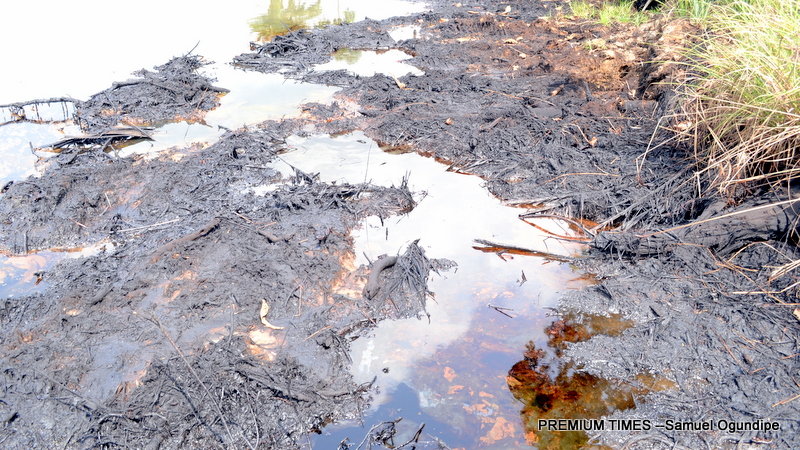Economy
Nembe Oil Spill: Expert Wants Preservation of Failed Wellhead for Analysis

By Adedapo Adesanya
An American university professor, Rick Steiner, has said between 532,000 and 1,064,000 barrels of crude oil has been spilt in the Nembe Oil Mining Lease (OML) 29 blowout, making the blowout one of the largest in world history.
Mr Steiner in a letter to the Nigerian National Petroleum Corporation (NNPC) Limited advised that the failed wellhead of the Nembe oil spill should be preserved for independent engineering forensic analysis to determine the cause of failure.
The professor, who is the Technical Advisor to the Ijaw Diaspora Council, said the failed wellhead should be assessed by either the US offshore oil regulatory agency, the Bureau of Safety and Environmental Enforcement (BSEE) and or Det Norsk Veritas (DNV) in Norway.
He maintained that the Nembe spill was much larger than government and industry statements suggest to date, and it would be prudent to correct those estimates.
“I understand that the Nembe OML 29 blowout may have been killed as of December 8, 2021, and as Technical Advisor to the Ijaw Diaspora Council, I wanted to provide you with my estimate of total discharge.
“If we assume 1-2 cubic feet of discharge per second (a very reasonable assumption), and that the blowout first occurred on November 1 (as reported by the Nembe communities), then the release lasted for a total of 38 days. This would have released a total of 532,000 barrels – 1,064,000 barrels of oil and gas, making the Nembe OML 29 blowout one of the largest in world history.
“Now that the blowout has apparently been killed, I urge you to preserve the failed wellhead for independent engineering forensic analysis to determine the cause of failure. The wellhead must be preserved as evidence, in standard criminal evidentiary procedures, to prevent any further alteration or adulteration, and then submitted to independent assessment.
“The people of Nigeria clearly deserve an independent assessment of what caused this catastrophic failure, and this is essential in preventing a repeat of this catastrophic failure in the future.
“I encourage the failed wellhead infrastructure to be assessed by either the U.S. offshore oil regulatory agency – the Bureau of Safety and Environmental Enforcement (BSEE) and/or Det Norsk Veritas (DNV) in Norway.
“Absent of a rigorous chain-of-custody, evidentiary preservation process for the failed equipment, and independent forensic evaluation, the true cause of the failure will never be conclusively determined.”
The university don regretted that the oil industry and government have been in the negative habit of underestimating oil spill volume, as was clearly seen in the 2010 United States’ deepwater horizon.
“A good example of the industry/government habit to underestimate spill volume was the 2010 Deepwater Horizon here in the U.S. BP and the US government first stated the flow rate from the failed seabed wellhead was 1,000 – 5,000 bbls/ day, and they clung to that estimate for some time (even though their internal engineers, and we, told them the flow was much higher).
“When an exact measure was finally conducted, using Particle Image Velocimetry and other engineering methodologies (by the Flow Rate Technical Group), the Macondo blowout outflow was put at 62,000 bbls/day. Again, this seems to always happen with spill volume estimates.”
Economy
NBA Demands Suspension of Controversial Tax Laws

By Modupe Gbadeyanka
The federal government has been asked by the Nigerian Bar Association (NBA) to suspend the implementation of the controversial tax laws.
In a reaction to the tax reform acts, the president of the group, Mr Afam Osigwe (SAN), the suspension of the laws would allow for a proper investigation into allegations of alterations in the gazetted and harmonised copies.
A member of the House of Representatives, Mr Abdussamad Dasuki, alleged that some parts of the laws passed by the parliament were different from the gazetted copy.
To address the issues raised, the NBA said it is “imperative that a comprehensive, open, and transparent investigation be conducted to clarify the circumstances surrounding the enactment of the laws and to restore public confidence in the legislative process.”
“Until these issues are fully examined and resolved, all plans for the implementation of the Tax Reform Acts should be immediately suspended,” the association declared.
It noted that the controversies “raise grave concerns about the integrity, transparency, and credibility of Nigeria’s legislative process.”
“These developments strike at the very heart of constitutional governance and call into question the procedural sanctity that must attend lawmaking in a democratic society,” it noted.
“Legal and policy uncertainty of this magnitude has far-reaching consequences. It unsettles the business environment, erodes investor confidence, and creates unpredictability for individuals, businesses, and institutions required to comply with the law. Such uncertainty is inimical to economic stability and should have no place in a system governed by the rule of law.
“Nigeria’s constitutional democracy demands that laws, especially those with profound economic and social implications, emerge from processes that are transparent, accountable, and beyond reproach. Anything short of this undermines public trust and weakens the foundation upon which lawful governance rests.
“We therefore call on all relevant authorities to act swiftly and responsibly in addressing this controversy, in the overriding interest of constitutional order, economic stability, and the preservation of the rule of law,” the organisation stated.
Economy
MRS Oil, Two Others Raise NASD Bourse Higher by 0.52%

By Adedapo Adesanya
Demand for hot stocks, including MRS Oil Plc, buoyed the NASD Over-the-Counter (OTC) Securities Exchange by 0.52 per cent on Tuesday, December 23.
The energy company was one of the three price gainers for the session as it chalked up N19.69 to sell at N216.59 per share versus the previous day’s value of N196.90 per share.
Further, FrieslandCampina Wamco Nigeria Plc gained N2.95 to close at N56.75 per unit versus N53.80 per unit and Golden Capital Plc appreciated by 84 Kobo to N9.29 per share from Monday’s N8.45 per share.
Consequently, the market capitalisation went up by N10.95 billion to N2.125 trillion from N2.125 trillion and the NASD Unlisted Security Index (NSI) rose by 18.31 points to 3,570.37 points from 3,552.06 points.
Yesterday, the NASD bourse recorded a price loser, the Central Securities Clearing System Plc (CSCS), which gave up 17 Kobo to close at N33.70 per unit against the previous trading value of N33.87 per unit.
The volume of securities traded at the session went down by 97.6 per cent to 297,902 units from the previous day’s 12.6 million units, the value of securities decreased by 98.5 per cent to N10.5 million from N713.6 million, and the number of deals remained flat at 32 deals.
By value, Infrastructure Credit Guarantee Company (InfraCredit) Plc ended as the most actively traded stock on a year-to-date basis with 5.8 billion units exchanged for N16.4 billion. This was followed by Okitipupa Plc, which traded 178.9 million units valued at N9.5 billion, and MRS Oil Plc with 36.1 million units worth N4.9 billion.
In terms of volume, also on a year-to-date basis, InfraCredit Plc led the chart with a turnover of 5.8 billion units traded for N16.4 billion. Industrial and General Insurance (IGI) Plc ranked second with 1.2 billion units sold for N420.7 million, while Impresit Bakolori Plc followed with the sale of 536.9 million units valued at N524.9 million.
Economy
NGX All-Share Index Soars to 153,354.13 points

By Dipo Olowookere
It was another bullish trading session for the Nigerian Exchange (NGX) Limited as it closed higher by 0.59 per cent on Tuesday.
The market further rallied due to continued interest in large and mid-cap stocks on the exchange by investors rebalancing their portfolios for the year-end.
Yesterday, Aluminium Extrusion sustained its upward trajectory after it further appreciated by 9.96 per cent to N14.90, as Austin Laz gained 9.81 per cent to close at N2.91, Custodian Investment improved by 9.69 per cent to N38.50, and First Holdco soared by 9.35 per cent to N50.30.
Conversely, Royal Exchange declined by 7.22 per cent to N1.80, Champion Breweries shrank by 6.57 per cent to N15.65, NASCON lost 5.36 per cent to trade at N105.05, Sovereign Trust Insurance depreciated by 5.28 per cent to N3.77, and Japaul went down by 4.51 per cent to N2.33.
At the close of business, 29 shares ended on the gainers’ table and 27 shares finished on the losers’ log, representing a positive market breadth index and bullish investor sentiment.
This raised the All-Share Index (ASI) by 895.06 points to 153,354.13 points from 152,459.07 points and lifted the market capitalisation by N579 billion to N97.772 trillion from the previous day’s N97.193 trillion.
VFD Group finished the day as the busiest stock after it recorded a turnover of 192.0 million units worth N2.1 billion, GTCO exchanged 63.5 million units valued at N5.6 billion, Access Holdings traded 49.8 million units for N1.0 billion, First Holdco sold 45.8 million units valued at N2.3 billion, and Secure Electronic Technology transacted 38.3 million units worth N28.4 million.
In all, market participants bought and sold 677.4 million units valued at N20.8 billion in 27,589 deals compared with the 451.5 million units worth N13.0 billion traded in 33,327 deals on Monday, showing an improvement in the trading volume and value by 50.03 per cent and 60.00 per cent apiece, and a shortfall in the number of deals by 17.22 per cent.
-

 Feature/OPED6 years ago
Feature/OPED6 years agoDavos was Different this year
-
Travel/Tourism9 years ago
Lagos Seals Western Lodge Hotel In Ikorodu
-

 Showbiz3 years ago
Showbiz3 years agoEstranged Lover Releases Videos of Empress Njamah Bathing
-

 Banking8 years ago
Banking8 years agoSort Codes of GTBank Branches in Nigeria
-

 Economy3 years ago
Economy3 years agoSubsidy Removal: CNG at N130 Per Litre Cheaper Than Petrol—IPMAN
-

 Banking3 years ago
Banking3 years agoFirst Bank Announces Planned Downtime
-

 Banking3 years ago
Banking3 years agoSort Codes of UBA Branches in Nigeria
-

 Sports3 years ago
Sports3 years agoHighest Paid Nigerian Footballer – How Much Do Nigerian Footballers Earn


















